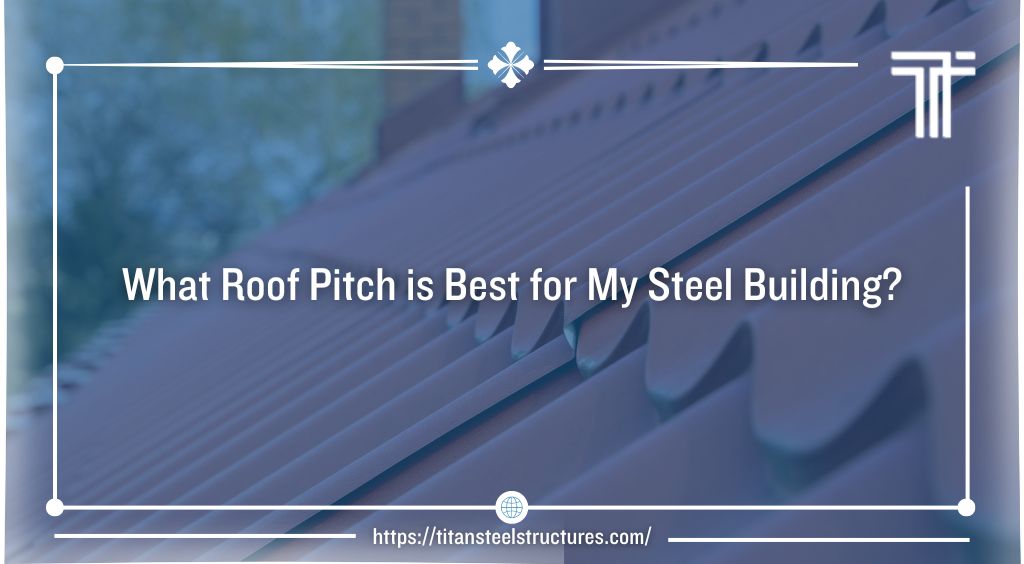Constructing a metal building can give you a high-quality, cost-effective structure that will last for decades. Pre-engineered steel buildings are typically boxlike, allowing for quick, economical construction. However, adapting your steel building design to your specific roofing requirements is easy. This could include installing a higher-pitch roof, which can change its appearance.
This article will explore steel building roof pitches and how to choose the best option for your project. You will learn about how to transform your structure by trading in flat roofing for an upscale, aesthetically pleasing roofing option.
Contact the team at Titan Steel Structures to learn more about steel building construction. Our experts can assist you with every stage of your project. Start your free customized quote today.
Roof Pitch: The Basics
When people talk about “roof pitch,” they are referring to the slope or rising in the roof for every foot of length along the structure’s roof. For example, a common 4:12 roof pitch means that the pitch rises 4 inches for every 12 inches of roof span.
Standard steel buildings have a roof pitch ratio of 1:12. This means that the pitch rises just an inch for every 12 inches of roof span. The result of this is a relatively flat roof and an overall box-like shape.
However, metal buildings are endlessly adaptable. You can add flair and personality with other pitched roof options, including a gable roof.
What are Common Roof Pitches for Steel Buildings?
Prefabricated metal building kits typically have a roof pitch between 1:12 and 4:12. Relatively low pitches like these can save time and money during construction. They may also reduce energy use, making the building cost-effective and energy-efficient.
However, installing a roof with a higher pitch, like a hip roof or gable roof, can increase interior space. Choosing a higher-pitched roof is often inexpensive and can increase the total cubic footage of your building.
Hip Roof vs. Gable Roof
When choosing a higher-pitched roof, you will probably come across two popular options: hip roofs and gable roofs. Understanding the benefits of these can help you choose the best option for your project.
Here is an overview of hip roofs and gable roofs.
Hip roofs
Hip roofs increase the visual appeal of a steel building. With a hip roof, the four sides of a hip roof slope down toward the walls. As a result, the building sits under the eaves of the roof’s sides. This creates a durable roof that forms a ridge at the top of the structure.
Gable roofs
Gable roofs slope downward toward the walls on two sides of a structure. The building’s walls extend from under the eaves up to the ridge’s peak on the remaining sides.
Pitched Roofs: Understanding Your Options
It is essential to consider your options and their benefits before choosing a roofing option. Here are some of the pros and cons of selecting a pitched roof for your steel structure.
Pros of a pitched roof
- A pitched roof allows water and snow to slide off, preventing pooling water on the roof
- Higher-pitched roofs allow for better visibility than flat roofs
- A sloped roof dissipated heat in non-air-conditioned buildings
- Installing a pitched roof may create extra living or storage space
- A sloped roof may be stronger and more stable than other options
- A pitched roof adds clearance above the eaves of your structure
Cons of a pitched roof
- A pitched roof may require more roofing materials, which will increase the overall project cost
- A hip roof’s dormers may be more vulnerable to leaks
Before installing a roof, consider your preferences and local weather conditions. Consult a Titan Steel Structures expert to determine which roofing options are right for your project.
Pros and Cons of a Flat Roof
Flat roofs are an economical choice for those who prefer an industrial, boxlike appearance. An industrial appearance may be appropriate for many structures, including storage facilities, warehouses, and manufacturing plants.
One of the most important considerations when choosing a flat roof is drainage. A flat roof may allow rain or melted snow to pool on top, which can increase the risk of leaks and water damage.
Flat roofs are also vulnerable to other severe weather conditions, such as strong winds and ice. If your structure will be in an area with heavy rain, strong storms, or several feet of snow, a higher-pitched roof may be a better choice.
Many people choose a flat roof because it is cost-effective during construction. However, it is crucial to consider future maintenance costs and repairs before making decisions about your structure.
Learn More About Roof Pitch Options for Steel Buildings
We are excited to work with you to create your ideal steel structure. Contact the experts at Titan Steel Structures now to learn about your roof pitch options or to get a customized quote for your project.

